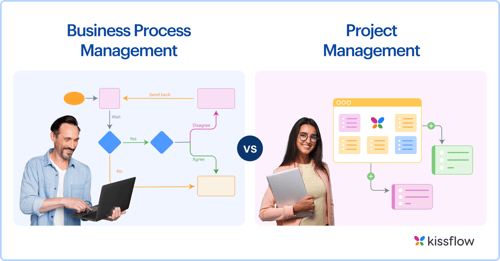Related Articles

Team Kissflow
Updated on 20 Jun 2025 • 5 min read
The debate between 'project' and 'program' is not a recent one in the corporate world. Even though their definitions seem to clearly outline the differences, in practical applications, the lines often blur. Both are vital components in any business landscape, each with its unique value proposition.
If you are a CEO or BTP, understanding these nuances is crucial for strategic decision-making.
A 'project' is typically a singular, focused endeavor with a specific outcome, whereas a 'program' is a collection of related projects managed in a coordinated way to obtain benefits that wouldn't be possible if managed separately.
The choice between a project or a program isn't about picking one over the other; it's about aligning your selection with the desired business outcomes. A project might be ideal for achieving a specific, time-bound objective, while a program could provide the comprehensive approach needed for larger, more complex initiatives.
So, as we navigate the complexities of business transformation, let's not view this as a 'project vs. program' debate but rather as an opportunity to leverage both in a way that best serves our strategic goals.
In this article, we’ll see exactly what the differences are and how to choose the right one for your requirements.
"A process is a set of data and a path for that data to follow. Think of it like a roller coaster. The car you sit in is like a form that captures a certain type of data. Then, the car goes along a predetermined process to bring it to completion."
Like projects, processes are collaborative. But unlike projects, processes can also include automated system tasks. All of the tasks for completion are known beforehand. Processes can include conditions and parallel branches to direct the data in different ways, but all of the structure is set up beforehand.
Processes can handle unlimited volume. With proper maintenance, a roller coaster can handle an unlimited number of rides. A process can continue to exist indefinitely as well, unlike a task and a project, which have end dates.
Process management tries to reduce the friction in the process to zero. It wants things to happen faster and more efficiently all the time, including identifying opportunities for automation.
At every point in the process, the person or system should have all of the information needed and nothing more. Data can also be pulled and pushed from existing data sets and complementary functional software such as financial or HR-related software.
No one needs to push the data; it just flows on its own. Data on the process can also be gathered and analyzed to determine how well the process is functioning.

Thanks for submitting the form.
Projects are generally collaborative. They involve a team of people doing several different tasks. Projects also have an end date and are not usually repeated in the exact same way.
The exact steps to complete the project aren’t always known at the beginning. The team might have an idea of how to execute a project, but they aren’t 100% confident. Projects have a lot of uncertainty about them, and tasks are often assigned ad-hoc depending on who is available or most skilled.
Projects also tend to have a limit on volume. A team can take on only so many projects at once. Some common project management tools are Kissflow, Trello, Basecamp, Asana, and Wrike. Many of these use a drag-and-drop interface where creating and assigning tasks is easy.
The project manager needs to have a full picture of what everyone is working on all at once, and it is helpful for everyone to be able to quickly communicate about a common project.
As soon as one stage of the project is completed, all of the data should be able to be parsed up and given to the next stage. If a new, unplanned step occurs, the team shouldn’t miss a beat.
In project management software, data must often be manually updated or moved. This is because these tools are designed to track the progress of tasks and projects based on the input they receive from users.
For example, if you're using a tool like Kissflow, you might create different lists to represent different stages of a project (like "To Do," "In Progress," and "Done"). As tasks move through these stages, you would manually move them from one list to another.
Similarly, if a task's due date changes, a team member would need to update this in the project management software manually. If a new task is created, someone needs to manually add it to the system.
This manual movement of data allows for flexibility and control, as it lets teams adapt to changes in real-time. However, it does mean that the accuracy and usefulness of the project management tool depend heavily on the team's diligence in keeping it updated.
Automation in project management software is becoming more common, but it's often limited to specific triggers and actions (like automatically changing a task's status if its due date passes). So, while some aspects can be automated, there's still a significant amount of manual work involved in using these tools.
Below are the top 5 differences between Project and Process
| Process Management | Project Management | |
| Goal | Efficiency | Transparency |
| Key Features | Intelligent Design, Integration | Flexibility, Quick Actions |
| Examples | Kissflow, Process Street, Process Maker | Kissflow, BaseCamp, Wrike, Asana |
| Built for | Companies | Teams |
| What happened to Data | Data Moves Automatically | Data Moves Manually |
Yes, recurring projects can indeed become processes. If a project is repeated regularly with the same steps and expected outcomes, it can be viewed as a process.
A process is a set of related activities that lead to a specific outcome. If you have a project that you do over and over again, and you've found a particular sequence of tasks that produces a successful result each time, that's essentially a process.
For example, if you run a marketing agency and you have a standard process for onboarding new clients, that could be considered a recurring project that has become a process. The steps might include things like an initial consultation, a proposal, a contract signing, and so forth.
The decision between using a process management tool (BPM) or a project management tool largely depends on the nature of your work.
Business Process Management (BPM) tools are ideal for managing repetitive tasks that follow a specific sequence or flow and need to be executed in the same manner each time. BPM tools help create, edit, and manage automated workflows. They are typically used for operations that are ongoing and predictable.
Project management tools, on the other hand, are more suited for tasks that have a definitive start and end date and might not be repeated in the future. They help in planning, scheduling, and tracking the progress of projects and are more focused on collaboration and resource allocation.
So, if your work is more about executing planned, one-time projects with a clear goal and deadline, a project management tool would be more beneficial. If your work involves managing ongoing, repetitive processes, then a BPM tool would be a better choice.
However, in many cases, business leaders use a combination of both types of tools to manage their work effectively. For instance, they might use a BPM tool for daily operations and a project management tool for special projects or initiatives.
As you can see, project management and process management are very different things. Which one do you need? Are you looking for a way to better organize all of your own tasks? Do you need a very flexible way to help your team complete projects? Or have your systems matured enough to where you should be focusing on creating efficient processes?
Many people use project management software to handle tasks or processes. While it’s possible to do this, it’s a stretch on the system because it isn’t what it was designed to do. When you want transparency, project management is the way to go. When you want efficiency, you need to change to process management.
Most businesses think they need project management software but would actually benefit more by managing their regularly occurring processes with BPM.
When you are ready to find a solution for your process management, try Kissflow low-code/no-code platform. can help you automate business processes in a matter of 15 minutes. Its drag-and-drop form builders and visual workflows allow you to build processes of varying complexity effortlessly.
Powerful reporting and analytics features provide valuable insight that can guide your process improvement efforts. You can secure your data with role-based conditional access.
Kissflow can integrate easily with other software your organization uses. It is built to scale effortlessly so that you can focus on growing your business without distractions.
Related Articles
Welcome.
Let's get started.
To begin, tell us a bit about yourself
By proceeding, you agree to our Terms of Service and Privacy Policy
"The beauty of Kissflow is how quick and easy it is to create the apps I need. It's so user-friendly that I made exactly what I needed in 30 minutes."
Oliver Umehara
IT Manager - SoftBank
A Trusted Choice for Companies Globally




Thank you for signing up
Someone from our team will contact you soon.

Know why all the IT leaders converging at booth #602
Earn a chance to be part of our experience event

Get the first look at the 2024 Citizen Development report
Welcome.
Let's get started.
By proceeding, you agree to our Terms of Service and Privacy Policy
Wondering where to start?
Let's talk!
Connect with our solution experts to gain insights on how Kissflow can help you transform ideas into reality and accelerate digital transformation

This website uses cookies to ensure you get the best experience. Check our Privacy Policy


